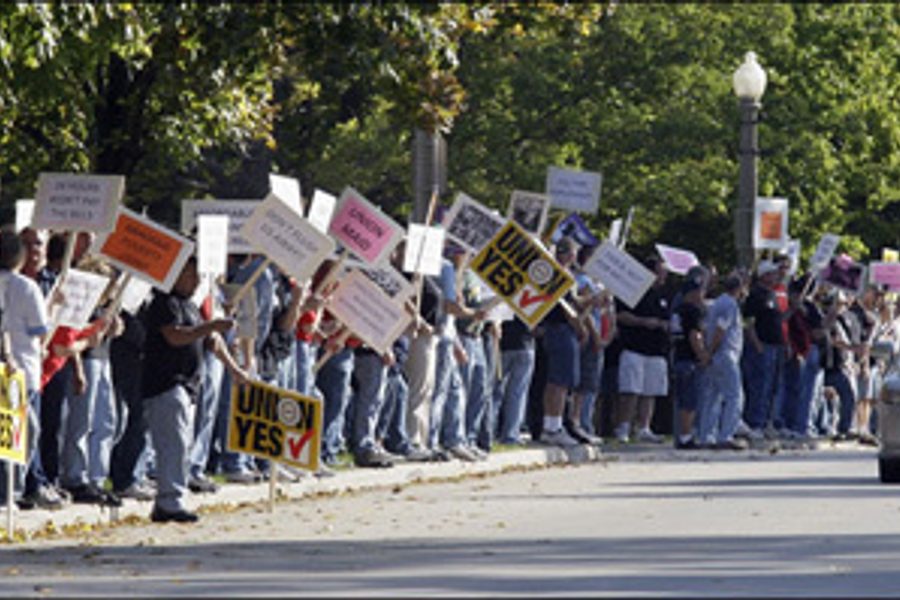
The outlines of a massive new structural downshift in wages are
emerging more and more clearly.
The largest wage-cutting wave since the Great Depression has already been sweeping the United States for the last couple years in response to the Great Recession. At small firms, many of these pay cuts have been viewed as a temporary means of reducing costs until the recession is fully ended.
The pervasiveness of this trend leads much of the public
to assume large corporations are merely seeking the same temporary
relief as small firms when they demand concessions in high-profile
negotiations. The workers’ pay will surely rise back to previous levels
when the situation improves for the company, as occurred during the 1980s, right?
Not this time around.The recession camouflages a far more insidious and long-lasting corporate strategy: Instead of temporary pay cuts to get through a few tough months, major corporations have something very, very different in mind.
As NY Times economics reporter and The Disposable American author Louis Uchitelle wrote on Sunday, major firms are on the verge of consolidating a long-sought goal with a two-tier wage system:
The managers of some marquee companies are aiming to make this concession permanent. If they are successful, their contracts could become blueprints for other companies in other cities, extending a wage system that would be a startling retreat for labor.
Though union officials said they could not readily supply data on the practice, managers have been trying to achieve this for 30 years, with limited results.
These firms are systematically implementing a major strategy to permanently drive down wages far below anything considered “middle class.” The key tool for corporations: forcing acceptance of permanent two-tier wage structures and the insertion of nonunion casual workers into union plants to drive down union pay to levels unimaginable a couple years back. Big business is essentially trying to take back the hard-won gains of working people won over generations.
As I reported on this site in various articles, the two-tier trend has emerged this year in Wisconsin at Mercury Marine (see here, here, and here) and Harley-Davidson (here, here, and here) and was demanded at the Kohler Corp. (here and here.) In each case, the powerful threat of relocating jobs provides the corporations overwhelming leverage to impose their low-wage vision of the future for working people.
According to Uchitelle,
The Kohler Company, another manufacturing giant in southeastern Wisconsin, famed for its gleaming bathroom fixtures, is negotiating a contract using Harley’s pact as a template and, so far, getting much of its way.
No doubt other corporations will find the “template” appealing because of the sharp cuts in labor costs it will permanently deliver. Kohler, for example, has been demanding a reshaping of the labor force along these lines:
- Tier A would be composed of currently employed workers — would face a five-year wage freeze, with current wages averaging $22.54 an hour.
- Tier B would be comprised by new hires and those on layoff for
more than 90 days, and they would earn 35% less (about $14.70 an
hour) and be burdened with a high-deductible healthcare plan
offering minimal coverage. - When a Tier A worker retires, his or her place would be taken by a Tier B worker — who would remain stuck in Tier B.
- The lowest-caste of “casuals” could work up to 25% of total hours in the plant under the company’s demands. They would also receive $14.70. Ineligible for union membership, they could be discarded at any time. They would also receive no healthcare benefits.
LOWER AND LOWER
At Harley, as Uchitelle notes, “The Milwaukee agreement, recently ratified, will shrink the full-time payroll to 900 from 1,250 today and more than 1,600 before the recession. Up to 250 “casuals”…will be used to handle surges in demand for Harley bikes.”
Mercury Marine, Harley-Davidson and Kohler have been pursuing a more advanced form of what many other firms have achieved. For example, new workers at GM and Chrysler are making just $14.50 an hour for grueling work on the assemblyline. Caterpillar also has imposed a two-tier wage system after long-running wars with the UAW in the 1990s, as has Delphi.
Expect the downward wage spiral to continue under relentless pressure from corporations who see an endless surplus army of labor with 9.6% unemployment and benefits running out for two million in Deember.
For example, “Toyota ‘s goal has become $12.64 an hour, the median wage for comparable manufacturing in Kentucky, where it has its largest plant, or $10.79 in Alabama, where it is building a new plant,” reports UC-Berkeley Prof. Harley Shaiken, a long-time scholar on labor issues and the auto industry.
Given the steadily-rising profits and the plummeting wages, Professor Andrew Sum of Northeastern University’s Center for Labor Market Studies, concludes grimly that this period of economic recovery “has seen the most lopsided gains in corporate profits relative to real wages and salaries in our history.”
RESULT: STUNNING INEQUALITY
Sen. Bernie Sanders more precisely outlined the outcomes of this unequal sharing of American prosperity as wages have been falling:
The statistics on income distribution in the U.S. are staggering in their inequality. According to the latest analysis, in 2005 the top 1 percent earned more income than the bottom 50 percent of Americans — with the top 300,000 earners making more money than the bottom 150 million.
With the continuing imbalance of power between workers and
corporations, we can expect the picture to grow only more lopsided
until workers discover new modes of effective resistance to unbridled corporate power.








